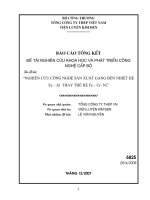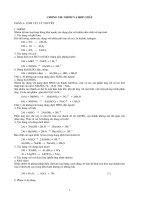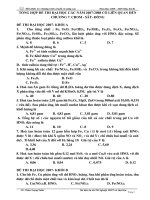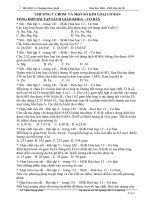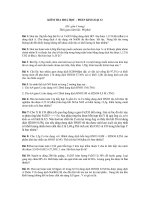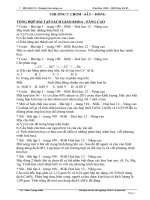Carlton CR ch25
Bạn đang xem bản rút gọn của tài liệu. Xem và tải ngay bản đầy đủ của tài liệu tại đây (876.1 KB, 71 trang )
Unit III
Creating the Image
Chapter 25
Digital Radiography
Objectives
• Describe various digital radiography
image receptor and detector systems
• Explain critical elements used in the
different digital radiography systems
• Discuss limitations inherent in currently
available digital radiography systems
Copyright © 2006 by Thomson Delmar Learning. ALL RIGHTS RESERVED.
4
Objectives
• Describe how the digital radiography
histogram is acquired
• Describe how the display algorithm is
applied to collected data
Copyright © 2006 by Thomson Delmar Learning. ALL RIGHTS RESERVED.
5
Objectives
• Explain why digital radiography systems
have greater latitude than conventional
film-screen radiography systems
• Analyze elements of digital radiography
systems
Copyright © 2006 by Thomson Delmar Learning. ALL RIGHTS RESERVED.
6
Objectives
• Discuss what makes them prone to
violation of ALARA radiation protection
concepts
• Explain the causes of sever digital
radiography artifact problems
Copyright © 2006 by Thomson Delmar Learning. ALL RIGHTS RESERVED.
7
Historical Development
• Fuji Systems
– 1980s
• Today’s Systems
– Several manufacturers
Copyright © 2006 by Thomson Delmar Learning. ALL RIGHTS RESERVED.
8
Indirect Photostimulable
Phosphor Imaging Plate Systems
•
•
•
•
Photostimulable imaging plates
Latent image production
Image acquisition
Reading digital radiography data
Copyright © 2006 by Thomson Delmar Learning. ALL RIGHTS RESERVED.
9
Photostimulable Imaging Plates
• Photostimulable
phosphor
– PSP
• Imaging plate
– IP
Copyright © 2006 by Thomson Delmar Learning. ALL RIGHTS RESERVED.
10
Common Phosphors
• Europium activated barium
fluorohalides
– Chemical formulas
• BaFBr:Eu
• BaFI:Eu
Copyright © 2006 by Thomson Delmar Learning. ALL RIGHTS RESERVED.
11
K-edge attenuation
• Best between 35 – 50 keV
– 35 keV: average energy of 80 kVp beam
• More exposure needed if applied kVp is
outside of this range
Copyright © 2006 by Thomson Delmar Learning. ALL RIGHTS RESERVED.
12
Scatter Radiation
• PSPs absorb more low energy radiation
than radiographic film
– More sensitive to scatter both before and
after exposure than radiographic film
Copyright © 2006 by Thomson Delmar Learning. ALL RIGHTS RESERVED.
13
Latent Image Production
• Electron pattern is stored in active layer
of exposed IP
• Fluorohalides absorb beam through
photoelectric interactions
– Energy transferred to photoelectrons
– Several photoelectrons liberated
– More electrons freed by photoelectrons
Copyright © 2006 by Thomson Delmar Learning. ALL RIGHTS RESERVED.
14
Latent Image Production
• Liberated electrons have extra energy
• Fluoresce - or- get trapped by
fluorohalide to create holes
Copyright © 2006 by Thomson Delmar Learning. ALL RIGHTS RESERVED.
15
Hole Formation
• Fluorohalide crystals trap half of the
liberated electrons
• Europium sites contain electron holes
– This is the actual latent image
Copyright © 2006 by Thomson Delmar Learning. ALL RIGHTS RESERVED.
16
Important Note!
• The latent image will lose about 25
percent of its energy in 8 hours, so it is
important to process the cassette
shortly after exposure
Copyright © 2006 by Thomson Delmar Learning. ALL RIGHTS RESERVED.
17
Image Acquisition
• IP cassettes
– Also know as filmless cassettes
– Can be used tabletop or with a grid
• Rules of positioning remain the same
• Wider latitude when compared to
film/screen radiography
Copyright © 2006 by Thomson Delmar Learning. ALL RIGHTS RESERVED.
18
Radiographic Technical Factor
Selection
“It is the responsibility of the radiographer
to select proper technique; chronic
overexposure should be avoided.”
• Ethical principles
• ALARA concept
Copyright © 2006 by Thomson Delmar Learning. ALL RIGHTS RESERVED.
19
Reading Digital Radiography
Data
• Trapped electrons are freed
– IP is scanned by finely focused neonhelium laser beam in a raster pattern
• Electrons return to lower energy state
– Emit blue-purple light
• Light captured by Photomultiplier (PM)
tubes
Copyright © 2006 by Thomson Delmar Learning. ALL RIGHTS RESERVED.
20
Reading Digital Radiography
Data
• PM tubes convert light to analog
electronic signal
• Analog electronic signal sent to analog
to digital converter (ADC)
• ADC sends digital data to computer for
additional processing
• IP erased via exposure to intense light
Copyright © 2006 by Thomson Delmar Learning. ALL RIGHTS RESERVED.
21
Reading Digital Radiography
Data
Copyright © 2006 by Thomson Delmar Learning. ALL RIGHTS RESERVED.
22
Reading Digital Radiography
Data
• Two types of IP processing
– Point by point readout
– Line by line readout
Copyright © 2006 by Thomson Delmar Learning. ALL RIGHTS RESERVED.
23
Reading Digital Radiography
Data
• Plate throughput
– 30 – 200 plates per hour
• Throughput and spatial resolution can
be improved by using dual-sided PSP
• Self contained units
– House plates and reader within upright
bucky or table
Copyright © 2006 by Thomson Delmar Learning. ALL RIGHTS RESERVED.
24
Reading Digital Radiography
Data
• PM tubes output signal
– Infinite range of values must be digitized
• Converted to limited, discrete values
– Automatically adjusted
• Optimizes handling during digitization
– Pixel depth
Copyright © 2006 by Thomson Delmar Learning. ALL RIGHTS RESERVED.
25
